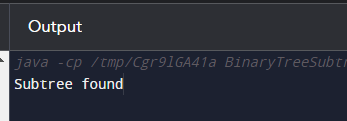Check if a Binary Tree is a Subtree of Another Binary TreeA tree of binary nodes is a sort of structure for data in which every node may produce a maximum of two children, referred to as both left and right siblings. The offspring belong to nodes, and each node has an opportunity for carrying a value. Binary trees are commonly employed in programming and computer science for various tasks that involve sorting, searching, and data storage. The following are some essential ideas of binary trees:
Binary trees may be used for various tasks and have many shapes. Common binary tree types include the following:
Critical points of Check if a Binary Tree is a Subtree of Another Binary Tree
The following actions are to determine whether one binary tree is a subtree of another binary tree:
Checking of Binary Tree is Subtree of Another Binary TreeOne may use a similar method as previously mentioned to determine whether one binary tree in Java is a subtree of another binary tree. Two functions must be implemented: one to determine whether two trees are identical and another to search for the subtree by going through the main tree. This is an implementation in Java: Java Code Output: 
Explanation we create a TreeNode class corresponding to Java code for displaying the binary tree's elements. The Identical function examines if both trees are identical, whereas the subtree function checks whether a subtree exists in the principal tree. The primary method shows how to use these methods to detect whether the binary tree in question is a subtree within a different binary tree. How to Tell if a Binary Network is a Subtree of an Additional Binary TreeA repetitious approach might be utilised to determine if one binary hierarchy is a subtree of another. Here's an instruction manual on how to achieve it as follows: 1. A Recursive Function's Definition: - Write a recursive function to determine whether a given binary tree is a subtree of another binary tree. This method will be run in the broader tree for every possible root node. 2. Normal Case: - Return false if the giant tree you are examining is empty (null). A bare tree isn't able to be a subtree of any tree. - Since an empty tree is regarded as a subtree of any tree, return true if the smaller tree is bare. 3. In contrast, Root Nodes - [Check whether the root nodes of the smaller and bigger trees are equivalent. If that doesn't happen to the case, return false. 4. Iterative Calls: - Recursively call the functions for the giant tree's left and right subtrees. This implies that you will ascertain whether the smaller tree is a subtree of the more enormous tree's present left and right subtrees. 5. Combine Findings: - The left and right subtrees must also be subtrees to establish whether the smaller tree is a subtree of the existing more enormous tree. Return true for the current call if the two recursive calls return true. If not, give back false. 6. Turnaround: - You will usually execute a pre-order, in-order, or post-order traverse of the enormous tree and call the recursive function for each node found to verify all potential root nodes in the enormous tree. ConclusionA typical issue in data structures and computer science is figuring out if one binary tree is a subtree of another binary tree. It entails comparing the two trees' architecture to ensure one tree is contained within the other. Selecting an effective technique for comparing the subtrees is crucial since, for big trees, the job can become computationally demanding. Many methods, such as identifying patterns and serializing, can speed up the subtree comparative operation. Upgrade to Premium Finally, determining if a binary tree is a subtree of a different binary tree requires a thorough navigation and comparing approach. The comparison method and traversal order selection can significantly impact the solution's efficiency. |
 For Videos Join Our Youtube Channel: Join Now
For Videos Join Our Youtube Channel: Join Now
Feedback
- Send your Feedback to [email protected]
Help Others, Please Share









